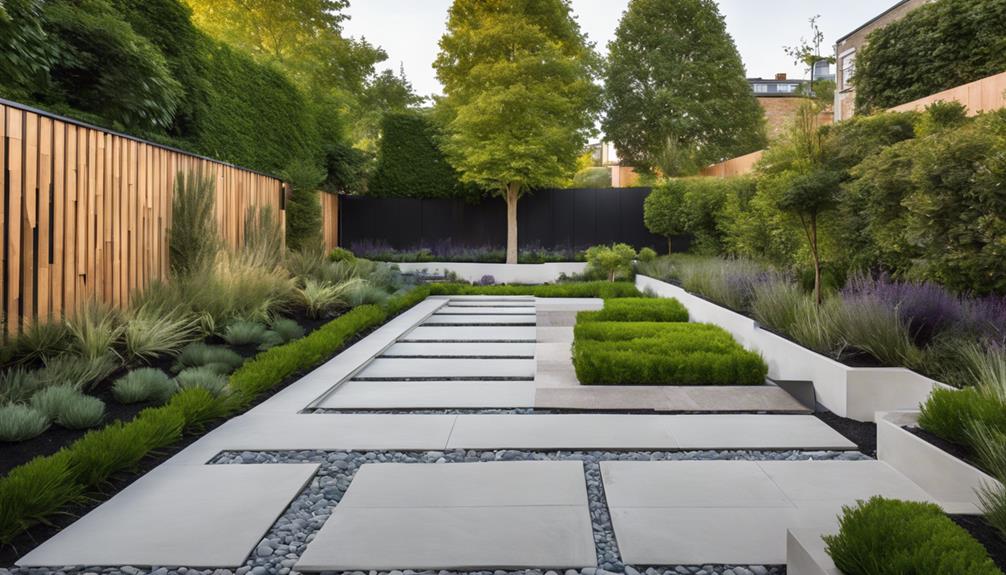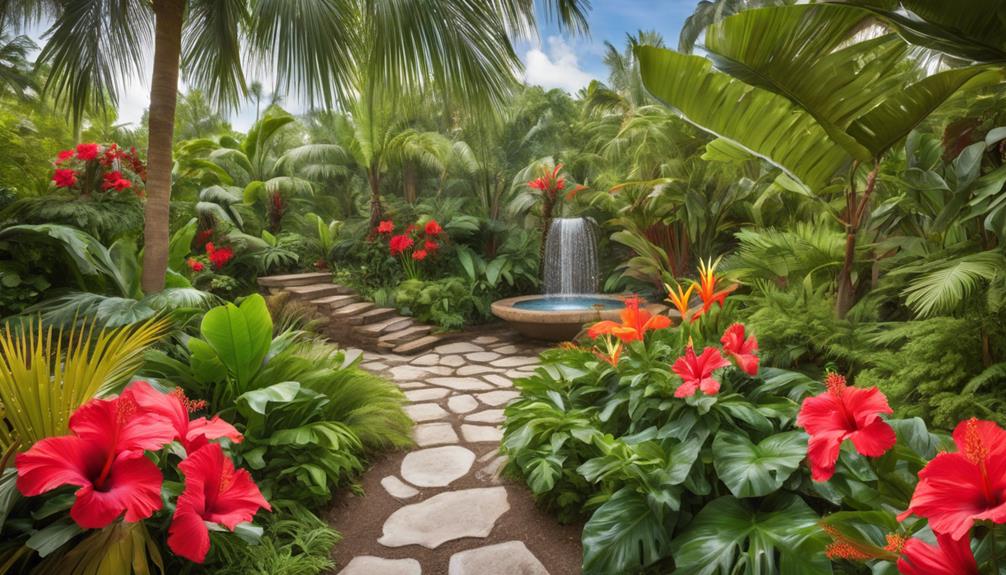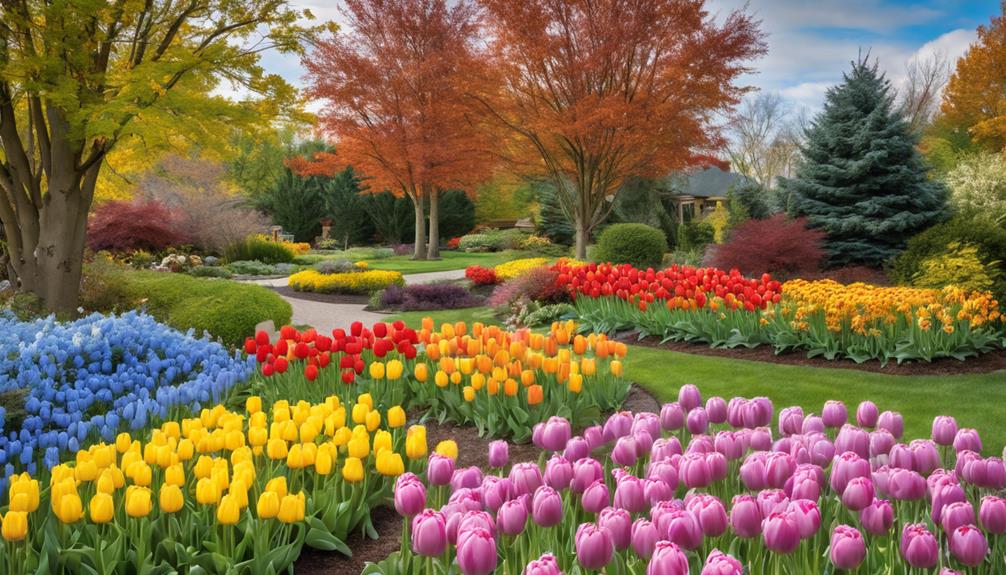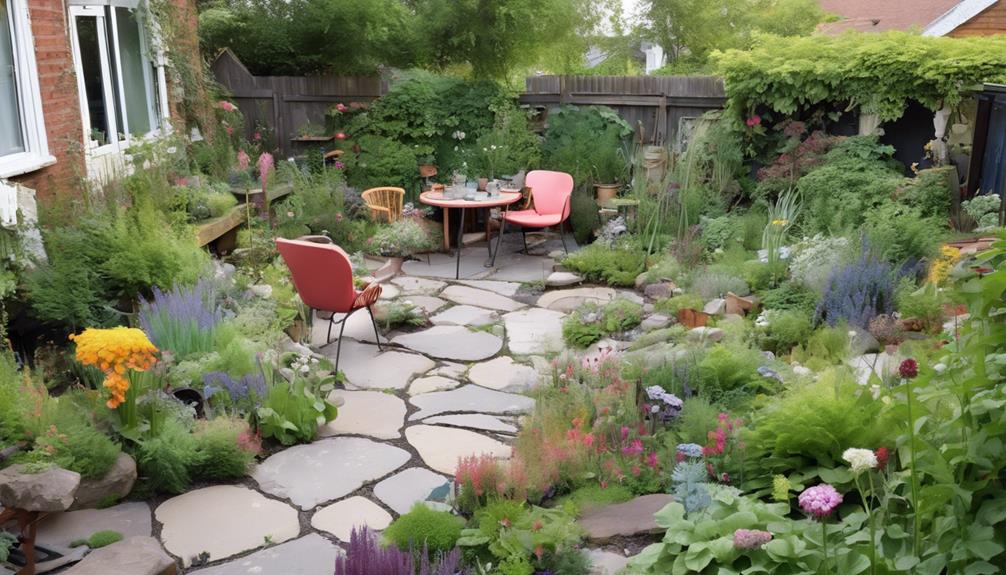
Pet-Friendly Lawn Care: A How-To Guide
30 January 2025
5 Best Local Experts for Seasonal Garden Cleanup
31 January 2025Stylish contemporary gardens for modern homes harmonise aesthetics with functionality. They prioritise seamless integration of materials, colours, and plant selections, creating visually appealing spaces that reflect individual lifestyles.
Key features include minimalist pathways, comfortable seating areas, and thoughtful lighting that enhances usability. Sustainable practices, such as choosing native and drought-tolerant plants, enrich the ecosystem while ensuring low maintenance.
Furthermore, implementing smart irrigation systems aids in effective water management. By focusing on these elements, one can achieve a vibrant, dynamic garden that stands the test of time.
Uncover more techniques to elevate your garden's design further.
Garden Aesthetics and Functionality
The balance between aesthetics and functionality is crucial in contemporary garden design.
By harmonising design elements, gardens can serve as both visually appealing spaces and practical outdoor areas for relaxation and entertainment.
Emphasising this duality allows for the creation of environments that enhance both the landscape and the user experience.
Harmonizing Design Elements
In contemporary garden design, achieving a seamless integration of aesthetics and functionality is vital for creating spaces that are both visually appealing and practical.
This harmonious relationship can be established through the careful selection of materials, colours, and plant varieties that complement architectural elements while serving specific purposes. For instance, the use of sleek, minimalist pathways not only guides movement but also enhances visual flow, while strategically placed seating areas invite relaxation amid lush greenery.
Additionally, incorporating sustainable practices, such as native plantings and efficient irrigation systems, not only elevates the garden's ecological value but also contributes to its overall beauty.
Practical Outdoor Spaces
Functionality is a cornerstone of practical outdoor spaces, where garden aesthetics seamlessly intertwine with everyday usability. A well-designed outdoor area should serve multiple purposes while enhancing the visual appeal of a modern home.
Consideration of elements such as seating arrangements, shade structures, and pathways can transform a garden into an inviting extension of the living space. Incorporating durable materials that withstand the elements ensures longevity, while strategically placed lighting enhances usability after dusk.
Furthermore, integrating native plants not only elevates aesthetics but also promotes sustainability. By harmonising form and function, contemporary gardens can foster a sense of tranquillity and serve as vibrant gathering spaces, ultimately reflecting the homeowner's lifestyle and design ethos.
Prioritising these principles leads to extraordinary practical outdoor environments.
Design and Plant Selection
In contemporary garden design, careful plant selection is vital for achieving both sustainability and aesthetic appeal.
By prioritising sustainable plant choices, ensuring colour harmony, and implementing seasonal planting strategies, designers can create vibrant and resilient landscapes.
These principles not only enhance visual interest but also promote environmental health.
Sustainable Plant Choices
Selecting sustainable plants for contemporary gardens involves careful consideration of local ecosystems and climate conditions. The integration of native and drought-resistant species not only enhances biodiversity but also minimises water consumption.
When curating your plant selections, consider the following key factors:
- Native Species: Choose plants that are indigenous to your region, as they are adapted to local soil and climate, thereby supporting local wildlife.
- Drought-Tolerant Varieties: Incorporate plants that require minimal irrigation, reducing water waste and maintenance efforts.
- Perennial Plants: Opt for perennials over annuals, as they provide long-term beauty and require less frequent replanting, contributing to soil health.
Color Harmony in Planting
Achieving colour harmony in planting is essential for creating visually appealing contemporary gardens. A well-planned colour scheme can enhance the overall aesthetic and promote a sense of tranquillity.
To master colour harmony, consider the following principles:
- Colour Wheel: Utilise the colour wheel to identify complementary, analogous, or triadic colour schemes that can create dynamic visual interest.
- Seasonality: Select plants that bloom in succession to ensure a continuous display of colour throughout the growing season, maintaining harmony and vibrancy.
- Focal Points: Incorporate bold, vibrant colours in selected areas to draw attention and create visual anchors within the garden space.
Seasonal Planting Strategies
While designing a contemporary garden, it is crucial to take into account seasonal planting strategies that align with both aesthetic appeal and plant health.
Implementing a thoughtful approach to plant selection can enhance visual interest throughout the year. Consider the following strategies:
- Diverse Seasonal Blooms: Select plants that offer a variety of flowering times, ensuring vibrant displays in spring, summer, and autumn.
- Foliage Variation: Incorporate evergreens and perennials with varying foliage textures and colours to maintain visual interest during the winter months.
- Succession Planting: Plan for staggered planting intervals to prolong the blooming period and create dynamic shifts in the garden's overall appearance.
Creating a Garden Plan
Creating a garden plan begins with an initial site assessment to understand the unique characteristics of the space.
This assessment should be complemented by effective soil health management techniques to ensure ideal growing conditions.
Furthermore, incorporating vertical gardening innovations can optimise space and enhance the overall aesthetic of contemporary gardens.
Initial Site Assessment
A thorough initial site assessment is crucial for developing a successful garden plan that harmonises with its surroundings. This assessment enables you to identify key elements that influence the design and functionality of your garden.
Consider the following factors:
- Sunlight Exposure: Determine the amount of sunlight different areas receive throughout the day, as this affects plant selection and arrangement.
- Microclimates: Identify variations in temperature and moisture within the site, which can dictate the types of plants that thrive in specific locations.
- Existing Structures and Features: Evaluate the impact of adjacent buildings, trees, and hardscapes on your garden's layout, ensuring that your design complements these elements.
Soil Health Management Techniques
Effective soil health management techniques are vital for establishing a robust garden plan that supports plant vigour and ecosystem balance.
Prioritising soil health not only improves plant growth but also fosters resilience against pests and diseases.
Here are three fundamental techniques to evaluate:
- Soil Testing: Regularly analyse soil composition and pH levels to tailor amendments that optimise nutrient availability.
- Organic Amendments: Incorporate compost, well-rotted manure, or cover crops to improve soil structure, boost microbial activity, and increase moisture retention.
- Crop Rotation: Implement a diverse planting schedule to disrupt pest cycles, replenish nutrients, and maintain soil fertility.
Vertical Gardening Innovations
With a solid foundation in soil health management techniques, gardeners can explore innovative approaches to maximise space and enhance aesthetics.
Vertical gardening innovations not only improve the visual appeal of contemporary homes but also optimise limited areas for plant growth.
To create an engaging vertical garden plan, consider the following strategies:
- Modular systems: Utilise stackable planters or wall-mounted pockets to create adaptable and scalable structures.
- Smart irrigation: Implement drip irrigation or self-watering systems to ensure efficient water usage and promote plant health.
- Varied plant selection: Choose a mix of ornamental and edible plants to enrich biodiversity and cater to different aesthetic preferences.
Enhanced Outdoor Living Space
Creating an enhanced outdoor living space transforms a garden into an extension of the home, blending functionality with aesthetic appeal. Thoughtfully designed areas promote relaxation and social interaction, enriching the overall experience of outdoor living. Key elements such as seating arrangements, lighting, and natural materials can significantly improve the ambiance.
| Element | Description |
|---|---|
| Seating Areas | Comfortable furniture for gatherings |
| Outdoor Kitchens | Cooking spaces that encourage entertaining |
| Ambient Lighting | Fixtures that create a warm atmosphere |
Incorporating these features will foster a seamless transition from indoor to outdoor environments, allowing homeowners to appreciate nature without compromising on style. Cultivating an inviting outdoor space is essential for contemporary living.
Smart Irrigation System Integration
The integration of smart irrigation systems is essential for maintaining the health and aesthetics of contemporary gardens.
By employing automated watering schedules, rainwater harvesting systems, and soil moisture sensors, gardeners can optimise water usage while promoting sustainability.
This approach not only conserves resources but also enhances the overall beauty and functionality of outdoor spaces.
Automated Watering Schedules
An automated watering schedule is a vital component of modern garden management, seamlessly integrating technology to optimise irrigation practices. By employing smart irrigation systems, gardeners can ensure that plants receive the appropriate amount of water at the right time, promoting health and sustainability.
Key benefits of automated watering schedules include:
- Precision Control: Adjust watering times and amounts based on specific plant needs, soil moisture levels, and environmental conditions.
- Water Conservation: Minimise water waste by delivering precise amounts, reducing runoff and evaporation.
- Convenience: Simplify garden maintenance through programmable settings, allowing for consistent care without manual intervention.
Implementing automated watering schedules improves the efficiency of contemporary gardens, aligning perfectly with modern sustainability goals.
Rainwater Harvesting Systems
Integrating rainwater harvesting systems with automated irrigation technologies elevates sustainable gardening practices to new heights. This synergy not only conserves water but also optimises resource efficiency. By capturing and utilising rainwater, gardeners can ensure their landscapes remain vibrant while minimising reliance on municipal water supplies.
Consider the following benefits of this integration:
- Cost Savings: Reducing water bills through efficient rainwater use and decreased dependence on irrigation systems.
- Environmental Impact: Lowering stormwater runoff and supporting local ecosystems by using naturally sourced water.
- Smart Control: Implementing automated systems that adjust irrigation based on rainwater availability, refining water usage.
These advantages position rainwater harvesting as a crucial element in contemporary garden design, promoting resilience and sustainability.
Soil Moisture Sensors Integration
The incorporation of soil moisture sensors enhances the efficiency of irrigation systems by providing real-time data on soil conditions. This technology boosts water conservation and promotes plant health by ensuring that irrigation occurs only when necessary.
Integrating soil moisture sensors into smart irrigation systems can yield numerous benefits, including:
- Precision Irrigation: Tailored watering schedules based on actual soil moisture levels, reducing water waste.
- Improved Plant Health: Ideal moisture levels ensure that plants receive adequate hydration, promoting stronger growth and vitality.
- Data-Driven Decisions: Continuous monitoring allows for informed adjustments to irrigation strategies, maximising resource efficiency.
Pest Management Strategies
Effective pest management is vital for maintaining the health and aesthetics of contemporary gardens.
Strategies such as introducing natural predators, employing companion planting techniques, and utilising organic pest repellents can greatly improve garden resilience while minimising chemical interventions.
Natural Predator Introduction
Often overlooked in conventional pest management strategies, the introduction of natural predators can markedly improve garden health and sustainability. This method emphasises the delicate balance of the ecosystem, allowing for effective pest control without harmful chemicals.
By fostering a habitat for beneficial species, gardeners can significantly reduce pest populations while enhancing biodiversity.
Consider these key natural predators to incorporate:
- Ladybirds: Effective against aphids and other soft-bodied insects, they can consume vast quantities of pests in a short time.
- Lacewings: Known as "aphid lions," lacewing larvae target numerous pests including thrips and spider mites.
- Parasitic Wasps: These tiny wasps lay their eggs inside pest larvae, effectively curtailing pest populations while remaining harmless to plants.
Integrating these predators fosters a thriving garden ecosystem.
Companion Planting Techniques
Incorporating companion planting techniques can greatly enhance pest management strategies within contemporary gardens. This method involves strategically pairing plants to improve growth, deter pests, and promote a balanced ecosystem.
Here are three effective companion planting strategies:
- Marigolds with Vegetables: Marigolds emit sulphur compounds that repel nematodes and various insect pests, making them beneficial partners for many vegetable crops.
- Basil with Tomatoes: Basil not only enhances the flavour of tomatoes but also repels aphids and whiteflies, protecting the tomato plants from these common pests.
- Nasturtiums with Cabbage: Nasturtiums act as a trap crop, attracting aphids away from cabbage and other brassicas, thereby reducing pest pressure.
Employing these techniques fosters a healthy garden environment, optimising both plant health and pest control.
Organic Pest Repellent Options
While traditional chemical pesticides can harm beneficial insects and the environment, organic pest repellent options offer sustainable alternatives for managing pests in contemporary gardens.
Employing these eco-friendly strategies not only protects your plants but also promotes a healthier ecosystem. Here are three effective organic pest repellent options:
- Neem Oil: Derived from the seeds of the neem tree, this natural oil disrupts pest life cycles, deterring numerous insects without damaging beneficial species.
- Diatomaceous Earth: Comprising fossilised algae, this powder acts as a mechanical barrier, effectively dehydrating and killing soft-bodied insects upon contact.
- Garlic Spray: A potent, homemade solution, garlic can repel a range of pests due to its strong odour, making it an excellent preventative measure.
Utilising these organic methods improves pest management while aligning with sustainable gardening practices.
Why Choose TKL Birmingham Gardener
Choosing the right gardener can significantly enhance the beauty and functionality of your outdoor space, and TKL Birmingham Gardener stands out as a premier choice for contemporary garden design.
With a reputation for excellence, TKL combines cutting-edge aesthetics with sustainable practices, ensuring that each garden reflects the homeowner's vision while harmonising with the environment.
Their team of skilled professionals possesses extensive knowledge in horticulture, landscape architecture, and the latest design trends, enabling them to create bespoke gardens that are both stylish and enduring.
TKL's commitment to quality craftsmanship and attention to detail guarantees that every project is executed with precision.
Common Garden Queries Answered
Navigating the world of gardening can often lead to a multitude of questions, especially for those looking to create a stylish contemporary garden.
Common queries range from plant selection to design principles. Selecting the right plants is imperative; opt for species that harmonise with modern aesthetics while ensuring seasonal interest.
Incorporating geometric shapes and clean lines in your layout promotes a contemporary feel. Furthermore, consider the role of hard landscaping—materials such as stone and metal can enhance your garden's modernity.
Water features and lighting also play critical roles, adding depth and ambience.
Garden Maintenance Schedule Recommendations
Establishing a stylish contemporary garden is just the beginning; a well-structured maintenance schedule is crucial for sustaining its beauty and health over time.
To achieve mastery in garden maintenance, consider the following recommendations:
- Weekly Tasks: Inspect plants for pests, deadhead flowers, and water as needed, ensuring ideal moisture levels.
- Monthly Duties: Prune shrubs and trees to encourage healthy growth, apply mulch to suppress weeds, and fertilise to increase nutrient availability.
- Seasonal Activities: Conduct soil tests to assess pH levels, plan for seasonal plant rotations, and prepare the garden for winter by protecting sensitive plants.
Adhering to this schedule will not only improve the aesthetic appeal of your garden but also foster a thriving ecosystem.




